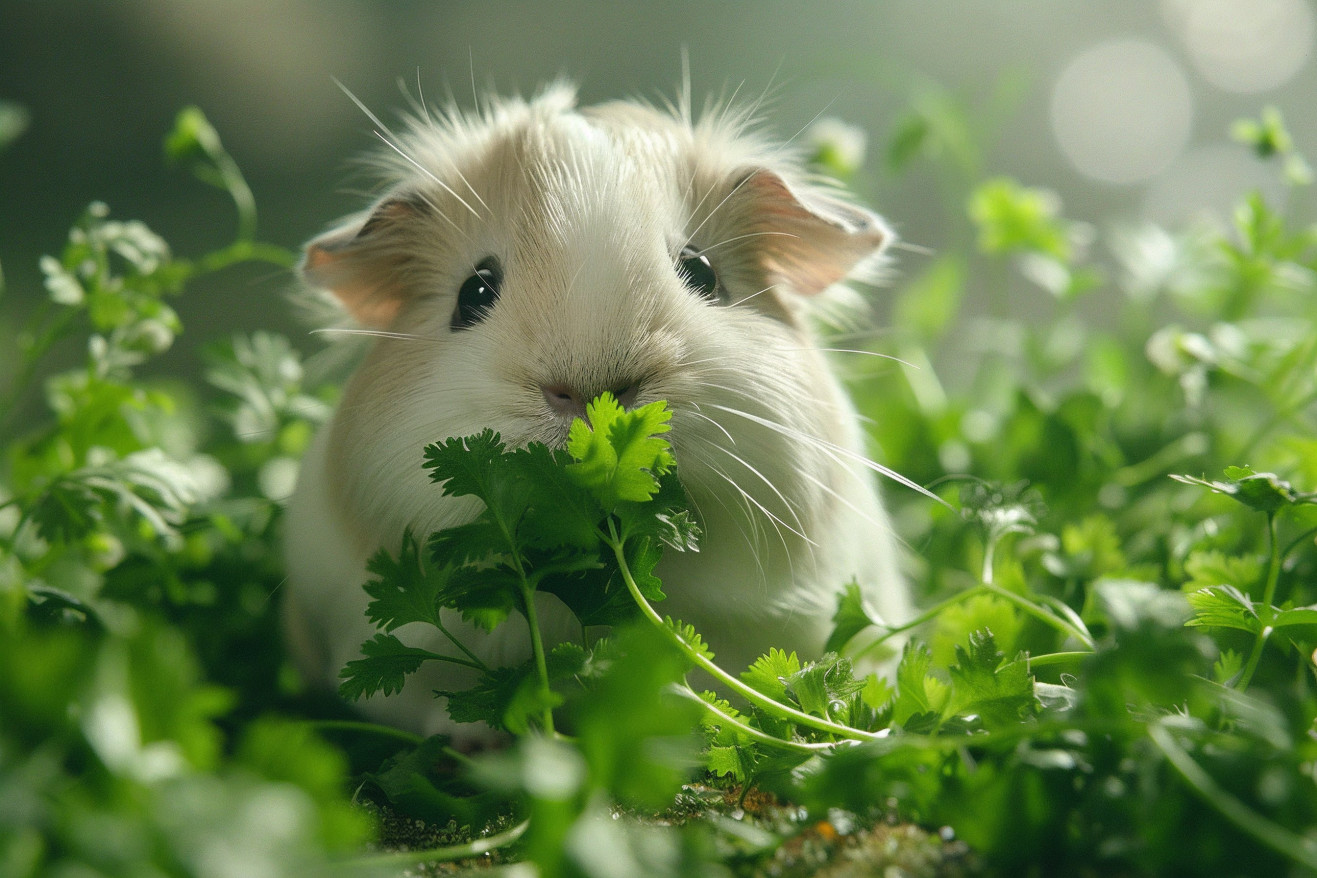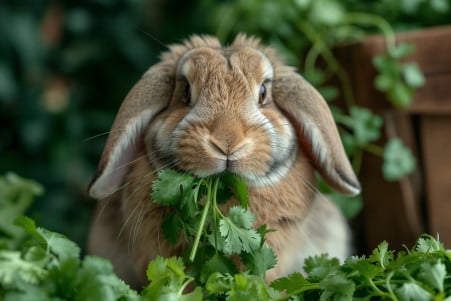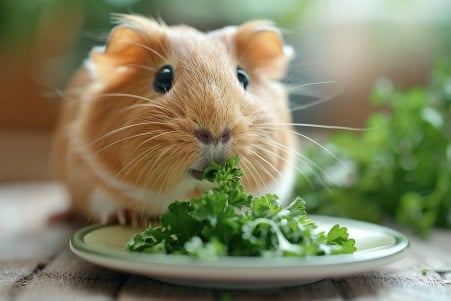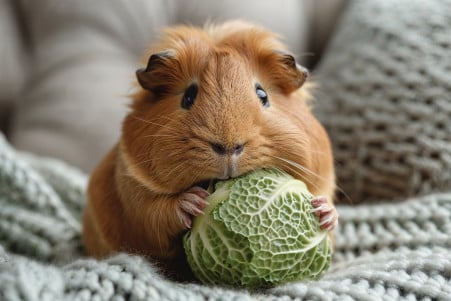Can Guinea Pigs Eat Cilantro? Nutritional Benefits Explained
15 February 2024 • Updated 14 February 2024

Cilantro is a popular herb with a distinctive aroma and flavor, but can guinea pigs eat it? The answer is yes, guinea pigs can eat cilantro. Cilantro is a safe and healthy herb for guinea pigs, and it is high in Vitamin C and has an ideal calcium-phosphorus ratio. However, to avoid potential tummy troubles, it should be fed in moderation and as part of a diet that includes other fresh veggies.
To help you better understand how cilantro fits into your guinea pig’s diet, we’ll share information from veterinarians and break down the nutritional content of cilantro. We’ll also discuss guinea pigs’ dietary needs and how cilantro fits in with other things they eat. Our aim is to provide a complete overview that will help you make sure your guinea pig is healthy and happy when you add cilantro to their diet.
Can guinea pigs eat cilantro?
Vitamins and Minerals in Cilantro: A Superfood for Guinea Pigs?
In addition to its delicious taste, cilantro is also known for its health benefits, especially in the world of pets, where it is the leafy part of the coriander seed.
One of the most important vitamins in cilantro is vitamin C, which guinea pigs can’t produce on their own, and cilantro provides a healthy dose at 1.1 mg per 4g serving, according to the site Nutrition Facts for Cilantro. This vitamin is essential for preventing scurvy, which is a real danger to guinea pig health.
Another important factor is the calcium-phosphorus ratio. Cilantro has 2.7 mg of calcium and 1.92 mg of phosphorus per serving, and this balance is important in preventing urinary issues in guinea pigs, as too much calcium can lead to bladder stones.
On top of that, cilantro has low levels of oxalates and sugars, which makes it a good addition to the diet, especially since guinea pigs are prone to diabetes and other sugar-related health problems.
While cilantro has these benefits, it’s important to remember that it should be fed in moderation. Overfeeding can lead to health problems, including the risk of bladder stones due to too much calcium. Therefore, it’s important to know the full nutritional content of cilantro so that you can make sure you’re feeding it to your guinea pigs in a way that’s healthy and responsible.
A Summary of Guinea Pig Nutrition: Understanding the Basics and Importance of a Healthy Diet
Guinea pigs have a specific nutritional need that is heavily reliant on Vitamin C and fiber. According to the Humane Society of the United States, guinea pigs are unable to produce their own Vitamin C, so they need a diet that can make up for this lack.
In the wild, guinea pigs eat a diet that is high in fiber, which mostly includes grass and wild plants, as pointed out by Supreme Petfoods. This diet helps their specialized digestive system, which includes a large caecum, to work properly to digest fiber and extract nutrients.
The RSPCA lists the dietary requirements as ad libitum good-quality hay for digestion and dental health, fresh grass, and leafy greens that are high in Vitamin C. It’s also important to watch calcium levels and limit oxalates in the diet to prevent issues like bladder stones. This is where cilantro can come in handy, as it is low in oxalates.
Like with any new food, make sure to introduce cilantro to your guinea pig slowly to prevent any stomach issues. Make sure to wash the cilantro thoroughly to remove any potential pesticides and start with small amounts, watching your guinea pig closely for any reactions.
Adding cilantro and other vegetables to your guinea pig’s diet will help ensure that they are getting the nutrients that they need while also protecting them from the dangers of nutritional deficiencies.
How to Feed Cilantro to Your Guinea Pig
Knowing how often and how much cilantro to feed your guinea pig is important to make sure you are giving them the right amount. Pet Keen explains that because of its high vitamin C content, cilantro can be a regular part of your guinea pig’s diet, but it should be fed in moderation.
Precisely Pets says that you should feed your guinea pig cilantro 2–3 times a week and give them 4–5 sprigs at a time. This will help ensure that your guinea pig gets the nutrients they need from the cilantro without giving them too much calcium, which can lead to bladder stones.
GuineaPiggles explains that cilantro is easy to grow at home and should be washed thoroughly to remove pesticides and other chemicals. After washing, cut the cilantro into small pieces and serve it with other guinea pig-friendly veggies like cucumber and carrots.
By giving your guinea pig a variety of vegetables and herbs, you can make sure they get a well-rounded diet, and by feeding them cilantro on different days, you can make sure their meals are always interesting and nutritious.
Keep an eye out for signs of an upset stomach, like diarrhea or a lack of appetite, as these can be signs of an adverse reaction. If you notice these symptoms, contact your vet to make sure your guinea pig is OK. By making sure to give your guinea pig a variety of foods that include cilantro, you can make sure they get the nutrients they need and satisfy their natural foraging instincts.
Cilantro in the Guinea Pig Diet: A Comparison
When comparing cilantro to other foods that guinea pigs eat, cilantro has a unique nutritional profile. It is high in the essential Vitamin C, which makes it a great choice for preventing scurvy, a concern that the PDSA emphasizes.
In contrast, other leafy greens like romaine lettuce and kale, which also have high levels of Vitamin C, according to the VCA Animal Hospitals, have a higher calcium content than cilantro, which means that cilantro is better for preventing urinary problems.
While cilantro is important for a well-rounded diet, it doesn’t take away from the importance of staples like hay, which should be the primary component of a guinea pig’s diet, according to Small Pet Select. Cilantro is a great addition to this diet, but it’s important to note that other vegetables like bell peppers and broccoli can also offer the same nutritional value.
Cilantro is a good addition to guinea pigs’ diets because it meets their nutritional needs and restrictions. However, it’s important to note that a well-rounded diet includes a variety of vegetables, in addition to cilantro. Responsible pet owners will mix cilantro with other recommended foods to ensure their guinea pigs get the nutrition they need and to prevent them from getting bored with their diet.
In Conclusion: Cilantro and Guinea Pig Health
Cilantro is a healthy and safe herb for guinea pigs when given in moderation. It is clear that cilantro has a number of nutritional advantages, especially in terms of its vitamin C, which is so important for guinea pig health. With a good calcium-phosphorus ratio and low oxalate content, cilantro is well within the dietary bounds of our little friends.
It is important for guinea pig owners to make sure that their pets are getting a well-rounded diet that meets their specific nutritional requirements. This means that new foods like cilantro should be introduced slowly and watched for any signs of an adverse reaction. By mixing other vegetables with cilantro, owners can ensure that their pets get a nutritionally balanced diet while also making sure that they enjoy their meals.
The road to a healthy and happy guinea pig is paved with good dietary decisions. Good nutrition is more than just a daily habit, it is a commitment to the health and longevity of our animal friends. So ends this tour through the world of guinea pig nutrition, but the story of love and care continues with the choices that are made in feeding guinea pigs.


